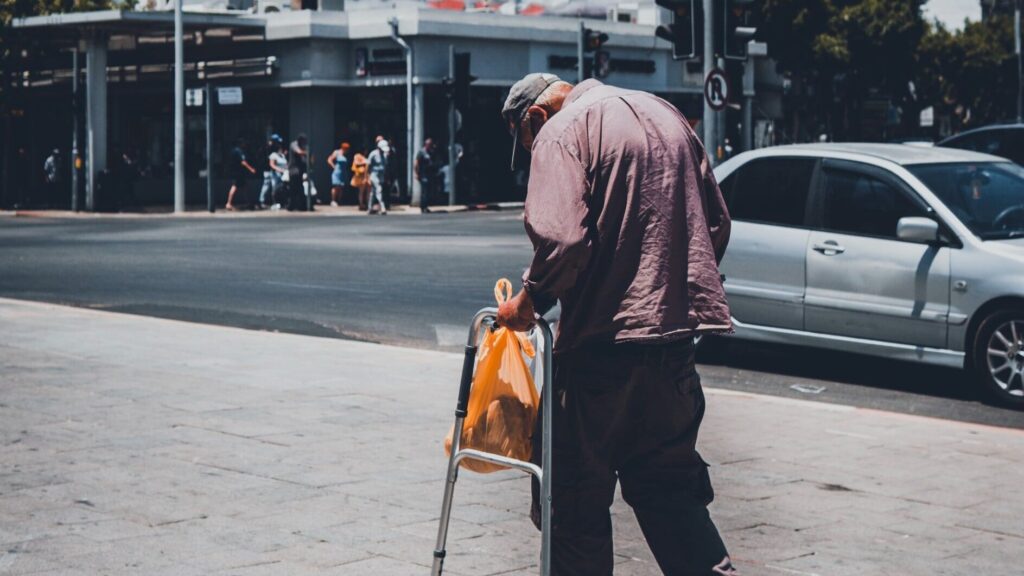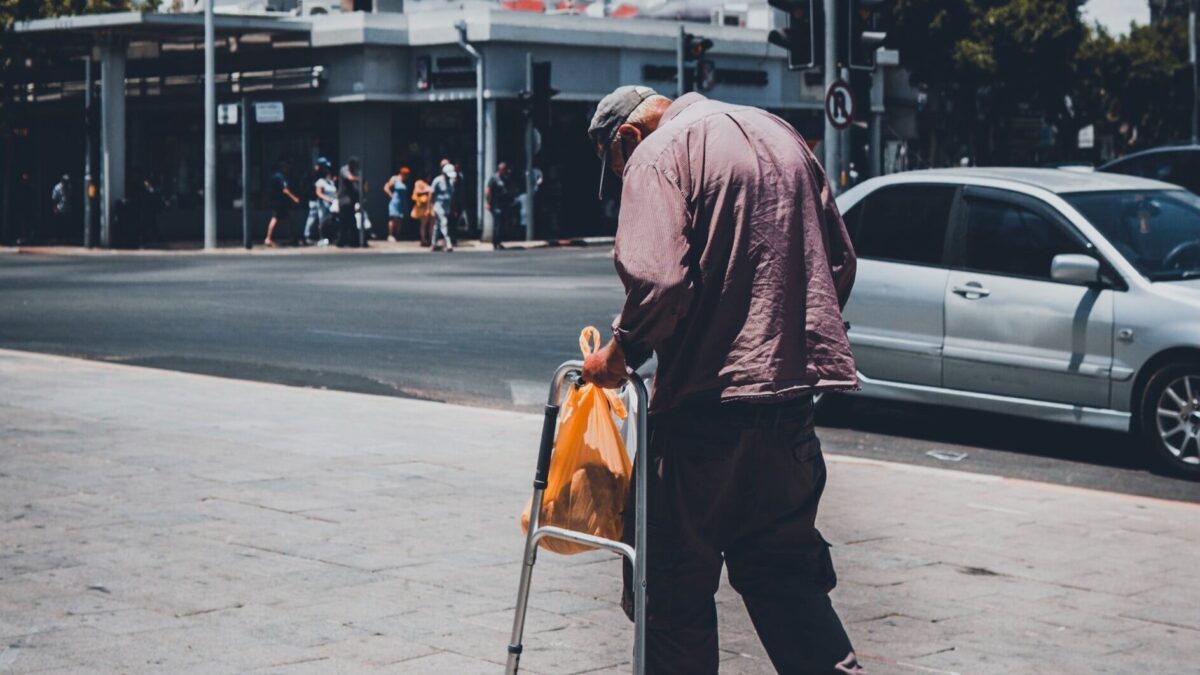Last Christmas, I had a lengthy and interesting debate with my mom about car dependence and the value of living in walkable places. Given her age and various health challenges, my mom was understandably suspicious about the idea of living without her trusty minivan. So I was surprised when she began sending me text messages this summer containing photos and detailed notes about her latest hobby: taking walks around the subdivision where she lives in Raleigh, North Carolina.
One includes photos of a park: “Discovered a labyrinth today!” One Friday night, my phone lights up with a photo of her smartwatch: “Walked six miles today!” She’s also been exploring public transit, so another photo features a smiling selfie of her sitting on a bench as she waits for the bus. In our phone calls, she tells me about businesses she’s discovered and new routes she has planned for the fall when the weather is cooler.
I’m proud of my mom for pushing back against car-dependence, but I’m also frustrated by the paradoxical nature of her experience. It’s similar to my experience as someone who relies mostly on a bike to get around here in Waco, Texas. On one hand, we’re both discovering liberation from not having to rely on a car for everything. But on the other hand, our ability to participate in the city has been severely limited. Mom can only go a certain distance and can only access certain businesses. I can’t get to certain neighborhoods and biking to social events at night is off-limits because there are no lanes or lights to protect me from Waco’s notorious late-night drag racers.
That full participation in the life of the city is restricted only to drivers strikes me as inequitable. I know it’s fashionable these days to describe dozens of urban issues as “inequitable.” Fortunately, with transit, it’s a bit easier to envision. If equity is essentially about fairness, then a city that approaches transit in an equitable manner is a city that strives to ensure that its citizens—no matter their age, physical condition, or income level—have fair access to participate in the civic, political, and economic processes that shape the city.
One might contend that this doesn’t matter that much, as participation is being digitized. But despite the growth of virtual community, movement and mobility remain at the core of meaningful participation. Humans are inherently transient, social beings. We need to get out of our homes and associate with each other. We need to see other people. Moving through our cities is a large part of how we bond with them and gathering together is how we bond civically to each other. No matter how much life we move online, there will always be limit to how much participation can meaningfully happen from the living room couch.
But once we’ve established that movement is (and, consequently, mobility and transit are) central to participation, the question remains: Don’t cars solve this problem? After all, everyone with a car can drive to whatever form of participation matters most to them, right? It may seem so, but the pervasiveness of driving in American cities obscures the extent to which car-centricity makes participation very difficult, if not impossible, for millions of citizens.
Let’s look at four populations for whom the requirement to drive is a participatory barrier.
Children and Teenagers

It would be unthinkable for the average American child or pre-teen to explore their neighborhood alone or with friends. With rivers of traffic and cars around every corner, it is simply unsafe, limiting children’s ability to explore, socialize, and engage with adults. I’ve seen children in New York City fully capable of placing a bagel order, navigating busy streets, and riding in a taxi without their parents. It’s dignifying and maturing for a child to be able to learn these essential rites of urban participation, but in car-based cities, it’s largely impossible.
For teenagers, the situation is even worse. Teens without a driver’s license are essentially house-locked, only able to participate in the city, commit to extracurriculars, see friends, or explore new interests if their parents are able and willing to drive them around. If cities provided safe non-driving transit options, not only would they improve the relationship of teens to their city, they would also expand the labor force and make their streets safer by taking more young people off the roads (and saving their lives).
Stay-at-home-Moms

Moms may be the most surprising feature of this list…at first, the cost of auto-dependence may not be clear here. Because they have no other alternative, moms are forced to spend a significant chunk of their time each week running short errands and driving children to and from school, sports and social commitments…up to 10 hours/week. The opportunity cost for moms in this scenario is extraordinarily high (not to mention the health costs). Those hours they spend driving are hours they could spend running a small business, reading, socializing or pursuing civic interests. Cities with more equitable transit options liberate time for their citizens and, for moms, this would be a huge win.
For single-car households, car-based design means thousands of women are forced to stay home alone with children. With no shops, parks or libraries in walking distance, it constitutes for many women a near mental-health crisis. One mom writes on this forum: “People in San Antonio drive crazy. The area I’m in has absolutely nothing around for me to do and no sidewalks so I can’t even feel safe going for a walk with my son. It’s very frustrating.” Another mom: “OMG this is MY LIFE! I’m at home with twins and I don’t drive and it’s so isolating…”
The Income-Vulnerable

Many mornings as I bike to work here in Waco, I see a handful of residents who, unlike the majority of the city’s residents, are not enclosed in a car hurtling down the city’s many stroads to work or school. Instead, they are struggling along Waco’s notoriously terrible sidewalks, navigating to their destination alongside a river of non-stop, fast-moving traffic.
Owning a car adds up to $10K to the cost of living, a prohibitive cost not just for the poor, but also for students, artists, entrepreneurs, and small business owners. Without a car, the poor living in suburban areas also have a harder time accessing job options. Extracurricular activities for their children are basically off the table. And starting a business or participating in civic events is much harder.
“The problem is not just that the poor are careless. Some of the most affluent Americans own no automobile. It is that a society that shorts public transportation in favor of the private vehicle deprives the poor of any other way to move.”
— Jane Holtz Kay, “Asphalt Nation”
For someone who is living a car-less life, the psychological experience of navigating the urban landscape without a car can make all the difference when it comes to hunting for a job, building a network of friends, buying fresh food (instead of fast food), or—for younger residents—being motivated at school.
Senior Citizens

For older people living in car-centric cities, the romance of the car quickly becomes a nightmare. As driving becomes more dangerous for them, alternative options like biking and using the bus become more desirable. Yet these options are often much costlier, unavailable, and sometimes too dangerous.
As a result, many senior citizens simply retreat. In their report, researchers at Transportation for America highlight the social and economic consequences of no longer being willing or able to drive: “Seniors aged 65 and older who no longer drive make 15 percent fewer trips to the doctor, 59 percent fewer trips to shop or eat out, and 65 percent fewer trips to visit friends and family, than drivers of the same age.”
Compared to cities like New York or many European cities where seniors can happily run errands, visit friends, and drop into their local pub, all on foot, the car-centric emphasis of North American cities essentially eliminates participation for one of our most vulnerable citizen groups, asking them to basically stay home while the rest of us speed around in our pickup trucks.
From a Harvard study quoted by Curbed in 2017: “By 2035, one out of three U.S. households will be headed by someone over 65. That’s 79 million Americans, or slightly less than the population of Turkey.” Without serious reevaluation of how our cities approach transit, that’s 79 million Americans who may be denied access to participation in the city.
Although promoted as a sign of freedom and individual liberty, the reality is the car only really works for a certain portion of the population: middle- to upper-class able-bodied individuals between the ages of 18-65. While driving remains a viable option for getting around, a city that is transit-equitable is a city that will look much more like the American cities of the 1800s, where various transit options made it possible for people, no matter their age, physical condition, or socioeconomic status, to participate in the social, economic, and political processes of the city.
The good news is that this vision of a more equitable approach to transit is attainable. Research and consumer trends show demand is up for less driving and more walkable places. Wise cities will find a way to capture this demand and transform themselves into places that give citizens the kinds of options they’re looking for. They will do this not only for the economic gains, but because they are compelled by the basic truth that no one should be excluded from the life of the city simply because they cannot get around.
A version of this article originally appeared on StrongTowns.
